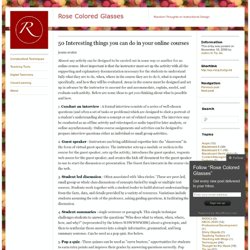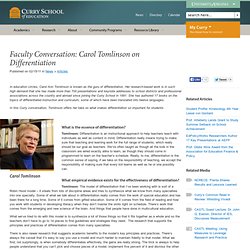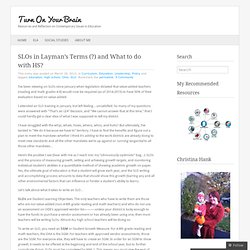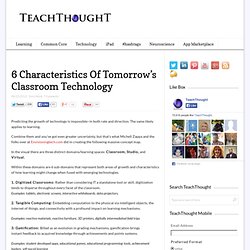

Formative Instructional Practice. 50 Interesting things you can do in your online courses. Almost any activity can be designed to be carried out in some way or another for an online course.

Most important is that the instructor must set up the activity with all the supporting and explanatory documentation necessary for the students to understand fully what they are to do, when, where in the course they are to do it, what is expected specifically, and how they will be evaluated. Areas in the course must be designed and set up in advance by the instructor to account for and accommodate, explain, model, and evaluate each activity. Below are some ideas to get you thinking about what is possible and how. 1. Conduct an interview : A formal interview consists of a series of well-chosen questions (and often a set of tasks or problems) which are designed to elicit a portrait of a student’s understanding about a concept or set of related concepts. 2. 3. 4. 5. 6. 7.
Faculty Conversation: Carol Tomlinson on Differentiation » Articles » Curry School of Education. In education circles, Carol Ann Tomlinson is known as the guru of differentiation.

Her research-based work is in such high demand that she has made more than 700 presentations and keynote addresses to school districts and professional associations across the country and abroad since joining the Curry School in 1991. She has authored 17 books on the topics of differentiated instruction and curriculum, some of which have been translated into twelve languages. In this Curry conversation, Tomlinson offers her take on what makes differentiation so important for students.
Carol Tomlinson What is the essence of differentiation? SLOs in Layman’s Terms (?) and What to do with HS? I’ve been stewing on SLOs since January when legislation dictated that value-added teachers (reading and math grades 4-8) would now be required (as of 2014-2015) to have 50% of their evaluation based on value-added.

I attended an SLO training in January, but left feeling….unsatisfied. So many of my questions were answered with “That’s an LEA” decision, and “We cannot answer that at this time,” that I could hardly get a clear idea of what I was supposed to tell my district. I have struggled with the whys, whats, hows, whens, whos, and huhs? But ultimately, I’ve landed in “We do it because we have to” territory. I have to find the benefits and figure out a plan to meet the mandate–whether I think it’s adding to the work districts are already doing to meet new standards and all the other mandates we’re up against or running tangential to all those other mandates… Let’s talk about what it takes to write an SLO… SLOs are Student Learning Objectives. What does it take to write an SGM? 1. Strengthening connected online communities of practice in education.
Twitter for Teachers. Tech Skills for Teachers. Twitter for Teachers. Tech Skills for Teachers. 6 Characteristics Of Tomorrow's Classroom Technology. Predicting the growth of technology is impossible–in both rate and direction.

The same likely applies to learning. Combine them and you’ve got even greater uncertainty, but that’s what Michell Zappa and the folks over at Envisioningtech.com did in creating the following massive concept map. In the visual there are three distinct domains/learning spaces: Classroom, Studio, and Virtual. Within these domains are 6 sub-domains that represent both areas of growth and characteristics of how learning might change when fused with emerging technologies. 1. 2. Examples: reactive materials, reactive furniture, 3D printers, digitally intermediated field trips 3. Examples: student developed apps, educational games, educational programming tools, achievement badges, self-paced learning 4. Examples: eyewear/HUDs, retinal screens, holography, neuroinfomatics, immersive virtual reality 5. 6. From the graphic: “Education lies at a peculiar crossroad in society. A pdf version of the visual can be found here.
Facebook Templates for Education. 100 Top Experts in #eLearning and #EdTech. The integration of education and technology has been an exciting field for decades, but the recent explosion of mobile consumer devices and wide availability of broadband Internet connections has rocketed the fields of eLearning and education technology into a new era.

Smartphones, tablets, and cheap laptops have helped millions of people connect with educational opportunities and tools for self-teaching. There is a rich conversation surrounding the topics of education technology going on all over the Internet, especially on Twitter, where many of the field experts interact and share their knowledge and links to their writing on the subject. We believe in technology’s ability to empower people to find educational opportunities and steer themselves towards success.
We think everyone interested in education technology can benefit greatly by participating in the rich online conversation surrounding EdTech and eLearning. K-12 Education & Learning Innovations with Proven Strategies that Work. The Educator's PLN - The personal learning network for educators. 25 – TED Talks/Ed. EdWeb.net - Networking, resource sharing, collaboration, and professional development for the education community.
Io's Instructional Management System (IMS) Response to Intervention.